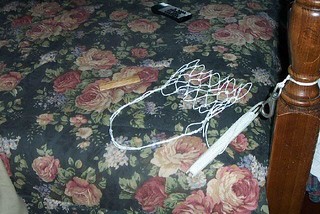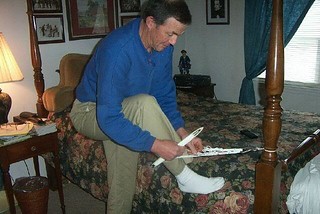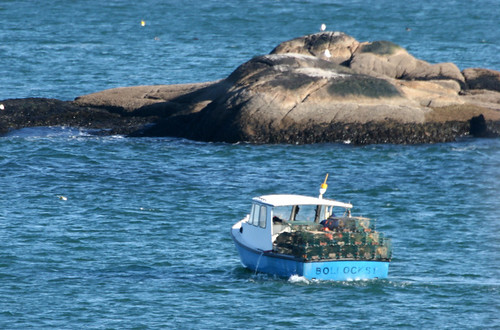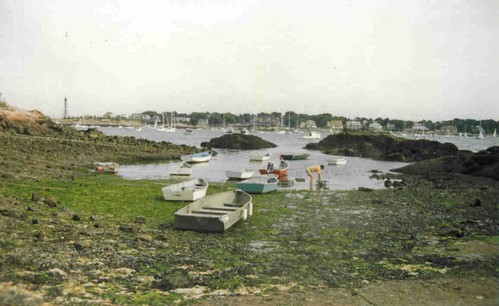(soon to be retired)
Read/Post Comments (15)
They That Go Down to the Sea in Ships
When I tell people that Paul is a lobsterman, they think "Oh, that must be so nice... to work out there on the water in the air and sea and sun, with no one to boss you around, coming and going at will, making your own hours..." etc., etc. Then they say "...and having the whole winter off!" and that's when I have to start in on the explanation of what it takes to be a lobsterman.
I won't bore you to tears here with all of that information, but I found this video (and you know I love videos!) that does a really great job of showing just what it takes for a lobsterman to build his own traps, which Paul does every year.
This year he bought 50 trap kits. They come with the wire mesh all cut to size for him, so the only part of this procedure that Paul doesn't really have to do is cut those first pieces out of the huge roll of mesh wire. He does have to trim things down to size, and then there is the rest of the process which is quite interesting as shown in this video.
The author has speeded it all up a bit in places, but you can see, if you watched it all, that just making this one lobster trap from a kit or from scratch can take quite a while and effort. Each one is made to specs that each lobsterman or woman determines is best for him or her. Yes, there are lobsterwomen around here but not a lot. I give huge kudos to those women to do this kind of work... they are tough cookies!
Paul not only builds his own traps like this each year (he will usually have to build 50 at least, more if he has lost a lot due to storms.. but he also knits his own nets for inserting into the traps. That process is time consuming, as well, and he does it up on his bed using the bedpost to hold the end of the "head" netting and using a shuttlecock type of instrument for the knitting of the heads.



Paul at work making lobster heads.
Not sure how long each one takes, but he'll do between one and three of them in an evening. He has about 475-500 traps in the water, and these heads always need replacing, as well.
There are also the bricks that get worked into the lobster traps (seen in the video above), and he's always on the lookout, during his beachcombing activities, for spare bricks. He has a little pile of them accumulated for when he builds new traps.
Here's Paul with his new air compressor machine which runs the air-gun seen in the video putting the clips onto the wire mesh. Also, you can see a few mangled traps that need attention to the left of Paul:

Lobstermen who build traps are always going beachcombing. It's one of the things Paul loves, I think. Quiet... peaceful... just the man and the beach and the sea. Trouble is that during these outings he will come across some of his gear, including whole traps, that have been tossed around by the almighty seas and deposited onto the beaches in deplorable and unusable condition. He will take these home and try to salvage as many parts of the trap as he can, but usually a bent-up trap has to go out front for the trash men to pick up.
An example of what Paul will find on a typical beachcombing expedition:


Trying to take apart all that gear is also time consuming. And these are several jobs that don't even include the repairing of traps, the sorting out of rope, buoys, bricks, heads, clips, bungee cords, etc. that go into a trap. Then he sets about repairing the banged-up traps that he has brought in from the ocean (which all by itself is a huge endeavor, considering he can only load about 25 of them on one boat-trip into the landing and then has to load them all up a gangplank to his truck, up into the truck, over to the house, and load them all into the driveway for stacking. He can't start the repair process until all the previously mentioned jobs are done and sorted out.

Paul moving traps or bringing them in.
All this work takes him all fall and winter to accomplish, even into the spring. By April and May he has a full complement of freshly repaired traps, newly cleaned and painted buoys, sorted ropes, and is ready to start hauling them all back into the sea again for another season of lobstering.
Paul keeps about 75 or 80 traps (I think he has 85 in now) in the water, as well as his lobster boat called "Bollocks!", all winter so he can get out there if/when we get a decent day. Like yesterday! What a beautiful day it was here, almost like spring. A funny kind of winter we are having.
So when people say it must be a great life to be a lobsterman, it reminds me of this picture I took many years ago of Paul getting some lobsters out of his crate, near where he moors his boat just off those rocks at Fort Sewall beach... in Marblehead. Yes, it's quite a life!

Not for everyone, but for the few who choose it, it has its payoffs, but those payoffs are hard won.

Paul showing a lobster he caught that was orange - still alive and kicking - not cooked - to our Kip. He took this guy back down to the ocean later and let him go... a lobster like this is rare, and we don't want to be cooking them if we can help it.
Cheers for the men and women of the sea,
Bex & Co.
Performed by the Choir at Ely Cathedral (England)
which is interesting because my Dad's ancestors came from Ely, England!
<><><><><><><><><><><><><><><><>
I won't bore you to tears here with all of that information, but I found this video (and you know I love videos!) that does a really great job of showing just what it takes for a lobsterman to build his own traps, which Paul does every year.
This year he bought 50 trap kits. They come with the wire mesh all cut to size for him, so the only part of this procedure that Paul doesn't really have to do is cut those first pieces out of the huge roll of mesh wire. He does have to trim things down to size, and then there is the rest of the process which is quite interesting as shown in this video.
The author has speeded it all up a bit in places, but you can see, if you watched it all, that just making this one lobster trap from a kit or from scratch can take quite a while and effort. Each one is made to specs that each lobsterman or woman determines is best for him or her. Yes, there are lobsterwomen around here but not a lot. I give huge kudos to those women to do this kind of work... they are tough cookies!
Paul not only builds his own traps like this each year (he will usually have to build 50 at least, more if he has lost a lot due to storms.. but he also knits his own nets for inserting into the traps. That process is time consuming, as well, and he does it up on his bed using the bedpost to hold the end of the "head" netting and using a shuttlecock type of instrument for the knitting of the heads.



Paul at work making lobster heads.
Not sure how long each one takes, but he'll do between one and three of them in an evening. He has about 475-500 traps in the water, and these heads always need replacing, as well.
There are also the bricks that get worked into the lobster traps (seen in the video above), and he's always on the lookout, during his beachcombing activities, for spare bricks. He has a little pile of them accumulated for when he builds new traps.

Lobstermen who build traps are always going beachcombing. It's one of the things Paul loves, I think. Quiet... peaceful... just the man and the beach and the sea. Trouble is that during these outings he will come across some of his gear, including whole traps, that have been tossed around by the almighty seas and deposited onto the beaches in deplorable and unusable condition. He will take these home and try to salvage as many parts of the trap as he can, but usually a bent-up trap has to go out front for the trash men to pick up.


Trying to take apart all that gear is also time consuming. And these are several jobs that don't even include the repairing of traps, the sorting out of rope, buoys, bricks, heads, clips, bungee cords, etc. that go into a trap. Then he sets about repairing the banged-up traps that he has brought in from the ocean (which all by itself is a huge endeavor, considering he can only load about 25 of them on one boat-trip into the landing and then has to load them all up a gangplank to his truck, up into the truck, over to the house, and load them all into the driveway for stacking. He can't start the repair process until all the previously mentioned jobs are done and sorted out.

Paul moving traps or bringing them in.
All this work takes him all fall and winter to accomplish, even into the spring. By April and May he has a full complement of freshly repaired traps, newly cleaned and painted buoys, sorted ropes, and is ready to start hauling them all back into the sea again for another season of lobstering.
Paul keeps about 75 or 80 traps (I think he has 85 in now) in the water, as well as his lobster boat called "Bollocks!", all winter so he can get out there if/when we get a decent day. Like yesterday! What a beautiful day it was here, almost like spring. A funny kind of winter we are having.
So when people say it must be a great life to be a lobsterman, it reminds me of this picture I took many years ago of Paul getting some lobsters out of his crate, near where he moors his boat just off those rocks at Fort Sewall beach... in Marblehead. Yes, it's quite a life!

Not for everyone, but for the few who choose it, it has its payoffs, but those payoffs are hard won.

Paul showing a lobster he caught that was orange - still alive and kicking - not cooked - to our Kip. He took this guy back down to the ocean later and let him go... a lobster like this is rare, and we don't want to be cooking them if we can help it.
Cheers for the men and women of the sea,
Bex & Co.
Performed by the Choir at Ely Cathedral (England)
which is interesting because my Dad's ancestors came from Ely, England!
THEY THAT GO DOWN TO THE SEA IN SHIPS,
that do business in great waters;
These see the works of the LORD, and his wonders in the deep.
For he commandeth, and raiseth the stormy wind, which lifteth up the waves thereof.
They mount up to the heaven, they go down again to the depths: their soul is melted because of trouble.
They reel to and fro, and stagger like a drunken man, and are at their wits' end.
Then they cry unto the LORD in their trouble, and he bringeth them out of their distresses.
He maketh the storm a calm, so that the waves thereof are still.
Then are they glad because they be quiet; so he bringeth them unto their desired haven.
Psalms, 107:23-3
"Prejudices, it is well known, are most difficult to eradicate from the heart whose soil has never been loosened or fertilized by education."
~~ Charlotte Bronte ~~
<><><><><><><><><><><><><><><><>
2003 - Present Archives at Diaryland
2007 - 2009 Archives at WordPress
2009 Archives at JournalScape
2010 Archives at JournalScape
2011 Archives at JournalScape
2012 Archives at JournalScape
2013 Archives at JournalScape
2014 Archives at JournalScape
Read/Post Comments (15)
Previous Entry :: Next Entry
Back to Top